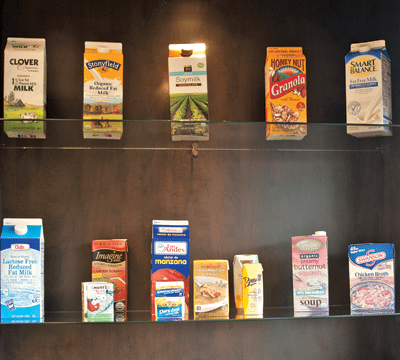Companies across the country are trying to get leaner, more efficient, and more environmentally responsible – and local packaging manufacturers are no different. As consumers, most of us might buy these businesses’ product in a store, use it, do our best to recycle the package, and not give it another thought. But in the effort to get more sustainable and more efficient, there’s a lot more behind that box, bag, or carton than we might think.
At Vancouver’s Tetra Pak, the company manufactures packaging for refrigerated drinks with the classic “gable-top” design, used predominantly for milk and juices. The Vancouver plant is part of a multinational corporation that manufactures many other kinds of packaging, including the cartons that are becoming more and more prevalent for shelf-stable foods like soup.
The power of paper
According to Tetra Pak’s national marketing and product manager Mary Therese Williams, cartons have a huge advantage over metals cans and plastic bottles.
“The carton is so much better for all parties involved – the consumer, the retailer and the environment. We see great opportunities for this type of packaging,” said Williams.
Cartons are made mostly from paper, which is a renewable resource, giving them an environmental edge over plastics made from petroleum products. They are also easily recyclable and lightweight, making them more cost-effective and fuel-efficient to ship.
Recycling rules
For today’s packaging manufacturers, the effort to be more efficient and sustainable goes much further than the product that goes out the door. Robert Baker, factory manager for Tetra Pak’s Vancouver plant, said that his company is “experimenting a little with different shapes and some other modifications,” but the gable-top carton design “is a fairly mature product. But from an environmental standpoint, we’re doing a lot to improve our footprint.”
“The big thing,” he added, “is our recycling rate. We’ve almost managed to exceed the 98 percent barrier.”
In 2011, according to Baker, Tetra Pak recycled more than 97 percent of its waste that would have otherwise ended up in a landfill.
“By implementing a low-cost manufacturing approach,” said Baker, Tetra Pak has worked diligently to improve its output and maximize efficiency. Lean manufacturing strategies have been a large part of this change – trying to find ways to reduce defective parts per million (PPM in Six Sigma terminology) leads to much better results and higher savings and efficiencies than more traditional efficiency measures like trying to improve percentages.
“We have used a disciplined approach that drives continuous improvement,” Baker explained.
Reducing waste
In terms of reducing waste, Tetra Pak’s lean approach has included auditing everything that leaves the plant as waste and “figuring out a way to recycle it.” This includes everything from materials used to make the containers, to the ink waste used to print them.
“Ink waste is classified as ‘dangerous waste,’” said Baker. “It’s made up of ink pigments and water. By using a filtering process, we can extract three-fourths of those materials out as clean water.” That leaves only one-fourth the amount of waste, which, thanks to the filtering process, is now classified as non-toxic. According the Baker, the company is working on finding a partner company who can re-use that remainder, so even that smaller amount won’t end up in a landfill.
The leftover trim from making cartons is sent back to the supplier, so it can be reused. Most of it, according to Baker, is recycled and used for tissue paper. Tetra Pak has also invested in a cooling tower, which eliminated the use of anti-freeze in the facility, and has made other energy-efficient investments like a lighting system that measures available light coming in through skylights and adjust the lighting accordingly.
Suited for sustainability
At Cowlitz Container, a custom die-cutter operation in Kelso, General Manager Ralph Clark confirms that package manufacturing customers are looking “more and more for sustainable options,” and for companies that are operating sustainably.
“I’ve had several inquiries about modeled pulp, which is 100 percent recycled,” Clark said. “For packaging inserts, like to hold bottles or electronics, you’re seeing the industry that had been using Styrofoam changing back over to using a paper product.”
“People are recognizing that some of these materials like Styrofoam just don’t go away,” he added. “Some of your plastics are somewhat recyclable, but with paperboard or cardboard there’s more of a tendency to try to recycle, from an end-user viewpoint.”
Clark said Cowlitz Container is working hard to get as efficient and sustainable as possible. One way the company is doing this, he explained, is by sending scrap material back to suppliers so it can be reused. Even a product like hard polyethylene plastic, once it’s cut and used, is ground up and sent back to the provider for re-use.
“We’re as lean and mean as you can get right now,” said Clark. “And when things turn around and the opportunities start falling out, we’re positioned to do quite well.”
Recognized for recycling
Tetra Pak has been so successful in its efforts to become more efficient and to recycle as much of its waste as possible that the company was recently nominated for Washington State Recycler of the Year, an award given by the Washington State Recycling Association.
“We’ll find out in the next week or so if we won,” said Robert Baker, factory manager for Tetra Pak’s Vancouver plant. “What makes us unique is that many companies have ‘green teams,’ but ours is actually part of the management process, driving improvement across the plant for all employees.”





